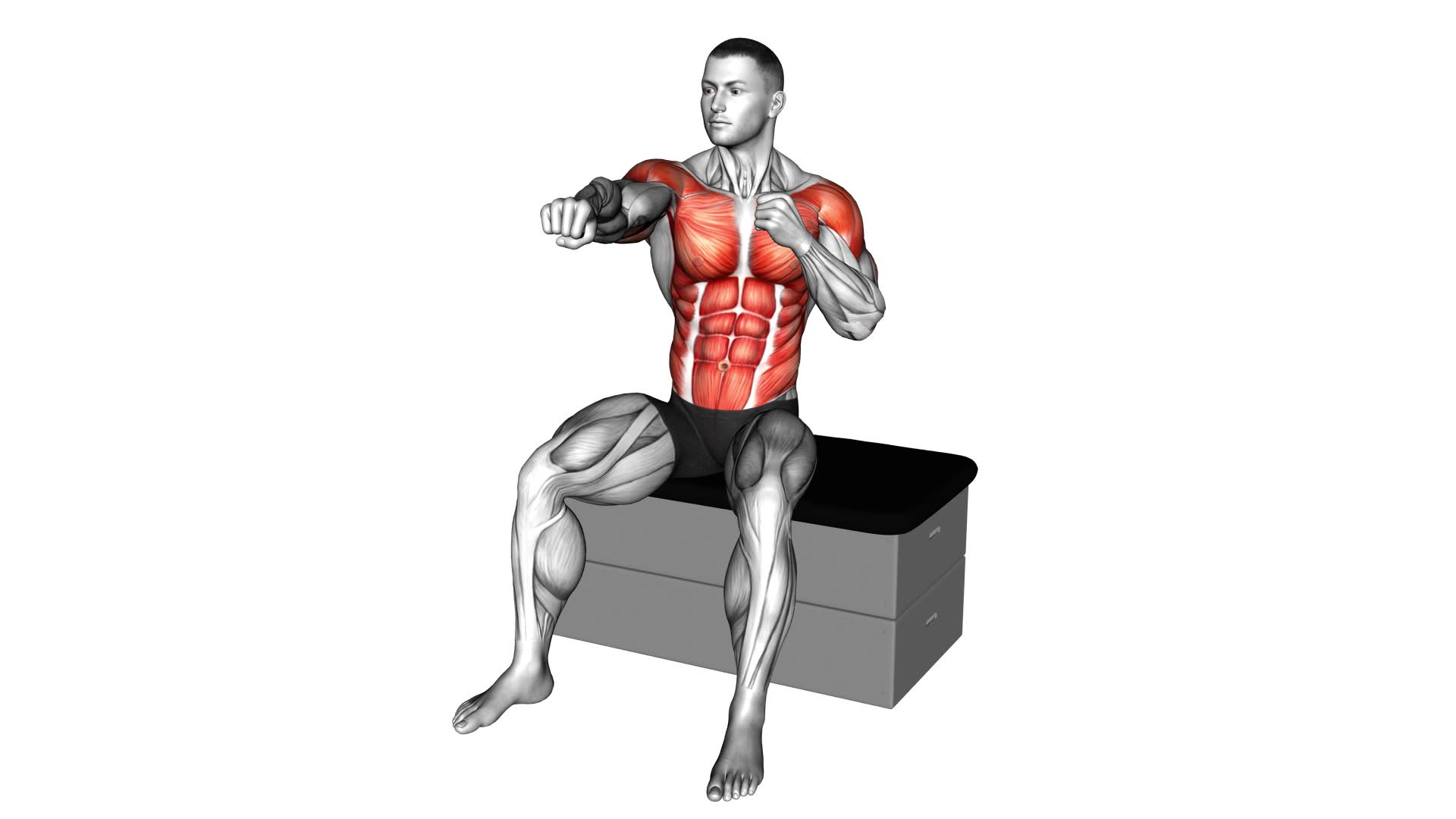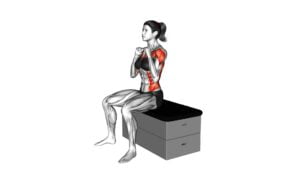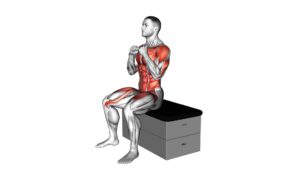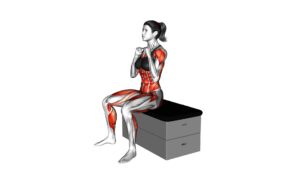Sitting Punch on a Padded Stool – Video Exercise Guide & Tips

Get ready to punch your way to a stronger core and upper body with the Sitting Punch on a Padded Stool. This video exercise guide and tips will show you how to maximize your workout and get the most out of each punch.
Watch This Exercise Video
Choose the right padded stool, perfect your form, and discover advanced variations to challenge yourself.
With these effective tips and techniques, you'll be on your way to a more powerful and toned physique.
Let's get punching!
Key Takeaways
- Sitting punch on a padded stool provides a great cardiovascular workout and engages core muscles for balance and stability.
- When choosing a padded stool, prioritize comfort level, consider height adjustability for proper form, and look for durability in materials.
- Proper form and technique for sitting punch include focusing on engaging the core, keeping wrists straight and aligned with forearms, and maintaining stable and upright posture.
- Core engagement during sitting punch can be achieved by activating abdominal muscles, keeping the back straight, and maintaining a neutral spine position with shoulders back and down.
Benefits of Sitting Punch on a Stool
You'll discover the numerous advantages of incorporating sitting punches on a stool into your workout routine. Not only does this exercise provide a great cardiovascular workout, but it also offers several benefits for your core engagement. By sitting on a stool, you're forced to engage your core muscles to maintain balance and stability while performing the punches. This means that with each punch, you aren't only working your arms and shoulders, but also strengthening your abdominal muscles.
One of the key benefits of sitting punches on a stool is improved core strength. As you punch, your core muscles contract and stabilize your body, helping to develop a strong and stable core. This can lead to better posture, reduced risk of back pain, and improved overall balance.
In addition to core engagement, sitting punches on a stool also provide a great workout for your upper body. The punching motion targets your arms, shoulders, and upper back, helping to build strength and tone in these areas. It can also improve your coordination and agility, as you have to coordinate your punches with your breathing and maintain balance on the stool.
Incorporating sitting punches on a stool into your workout routine can be a fun and effective way to strengthen your core and upper body. Give it a try and start reaping the benefits today!
Choosing the Right Padded Stool
To find the ideal padded stool for your sitting punch exercise, consider factors such as comfort, height adjustability, and durability.
When choosing a padded stool, it's important to prioritize your comfort level. Look for a stool that's ergonomically designed, with cushioning that provides adequate support for your body. A comfortable stool will allow you to focus on your exercise without distractions or discomfort.
Additionally, consider the height adjustability of the stool. This will ensure that you can find the perfect height to maintain proper form and technique during your sitting punch exercise.
Lastly, durability is key. Look for a padded stool that's made from high-quality materials and is built to last. This will ensure that your stool can withstand the demands of your exercise routine.
By choosing a padded stool with an ergonomic design, a high comfort level, and durability, you're setting yourself up for success in your sitting punch exercise.
Now, let's move on to the next section and learn about the proper form and technique for the sitting punch.
Proper Form and Technique for Sitting Punch
To perform the sitting punch with proper form and technique, focus on engaging your core throughout the movement. This will help stabilize your body and generate power in your punches.
Additionally, be mindful of avoiding wrist strain by keeping your wrists straight and aligned with your forearm.
Core Engagement During Sitting Punch
To engage your core properly during the sitting punch exercise, make sure that you maintain a stable and upright posture throughout the movement. Here are three key tips to help you maximize your core stability during this exercise:
- Activate your core: Before you start the sitting punch, take a moment to engage your abdominal muscles by pulling your belly button towards your spine. This will help stabilize your core and protect your lower back.
- Keep your back straight: Avoid slouching or rounding your back during the exercise. Instead, maintain a neutral spine position with your shoulders back and down. This will ensure that your core muscles are properly engaged throughout the movement.
- Breathe deeply: Remember to breathe deeply and exhale forcefully as you punch. This will help you generate more power and engage your core even further.
By following these tips, you'll not only strengthen your core but also improve your overall posture and stability.
Now, let's move on to the next section and learn how to avoid wrist strain during the sitting punch exercise.
Avoiding Wrist Strain
Proper form and technique are essential for avoiding wrist strain during the sitting punch exercise. To reduce wrist strain, it's important to maintain a straight and neutral wrist position throughout the movement. Avoid bending or hyperextending your wrists, as this can put unnecessary stress on the joint.
Additionally, incorporating wrist strengthening exercises into your routine can help build the muscles and tendons surrounding the wrist, providing better support and stability. Exercises such as wrist curls, wrist rotations, and grip exercises can all contribute to improved wrist strength.
Advanced Variations of Sitting Punch
For advanced variations of the sitting punch, incorporate different angles and intensities to challenge your muscles and enhance your workout. Here are three advanced modifications to take your seated boxing techniques to the next level:
- Cross Punch: Start with your feet shoulder-width apart and sit tall on the padded stool. As you punch, rotate your torso and extend your opposite arm across your body, aiming for an imaginary target. This movement engages your core muscles and adds rotational power to your punches.
- Hook Punch: Maintain a strong posture and position your feet wider than shoulder-width apart. Instead of punching straight ahead, bend your elbow and swing your arm in a circular motion, aiming to hit your target from the side. The hook punch targets the muscles in your arms, shoulders, and back, giving you a challenging upper body workout.
- Uppercut Punch: Stand up on the padded stool and position your feet hip-width apart. Bend your knees slightly and punch upward, focusing on driving your fist from a low position to an imaginary target above your head. This variation targets your core, shoulders, and arms while also improving your overall punching power.
Incorporating these advanced variations into your sitting punch routine won't only keep your workouts challenging and exciting but also help you build strength, improve coordination, and boost cardiovascular fitness.
Keep pushing yourself and enjoy the benefits of these advanced seated boxing techniques.
Tips for a More Effective Sitting Punch Workout
To make your sitting punch workout more effective, incorporate these tips for optimal results.
First, focus on engaging your glutes during the exercise. By squeezing your glute muscles, you can create a stable base and generate more power in your punches. This won't only improve the effectiveness of the workout but also help strengthen your glutes.
Another tip is to incorporate upper body rotation into your sitting punch. As you punch, rotate your torso in the direction of the punch. This will engage your core muscles and increase the intensity of the workout. By adding this rotational movement, you can target more muscles and enhance the overall effectiveness of the exercise.
By engaging your glutes and incorporating upper body rotation, you can maximize the benefits of your sitting punch workout. These tips won't only help you build strength and improve your punching technique but also make the workout more engaging and enjoyable.
Now that you know how to enhance your sitting punch workout, let's move on to the next section and discuss common mistakes to avoid when doing this exercise.
Common Mistakes to Avoid When Doing Sitting Punch
When performing the sitting punch, it's important to focus on proper form techniques and avoid using excessive force.
Maintaining proper form ensures that you're targeting the right muscles and minimizing the risk of injury.
By avoiding excessive force, you can prevent strain on your joints and maintain a controlled and effective workout.
Proper Form Techniques
Ensure that you maintain proper form while performing the sitting punch exercise to avoid common mistakes. Here are some key tips to help you achieve the correct form:
- Sitting Punch Modifications:
- If you have difficulty balancing on a padded stool, try performing the exercise on a stable chair or bench.
- If you have a weak core or lower back, place a small cushion behind your lower back for support.
- If you have wrist or shoulder issues, modify the exercise by using lighter weights or performing punches without weights.
- Common Misconceptions about Proper Form in Sitting Punch:
- Avoid slouching or leaning forward, as this can strain your back and compromise the effectiveness of the exercise.
- Keep your wrists straight and aligned with your forearms to prevent injury and maximize power.
- Engage your core muscles throughout the exercise to maintain stability and prevent excessive strain on your lower back.
Avoiding Excessive Force
To avoid excessive force and prevent potential injuries, make sure you maintain proper technique while performing the sitting punch exercise.
First and foremost, engage your core throughout the movement. This won't only provide stability but also activate your abdominal muscles, allowing for a more controlled punch.
Another common mistake to avoid is overextending your punches. While it may feel more powerful to fully extend your arm, it puts unnecessary strain on your joints and increases the risk of injury. Instead, focus on using controlled and fluid movements, keeping your punches within a comfortable range.
Lastly, listen to your body and take breaks when needed. Pushing through fatigue can lead to poor form and increased risk of injury. Remember, injury prevention is key to maintaining a successful fitness routine.
Frequently Asked Questions
Can Sitting Punch on a Padded Stool Help in Improving Overall Body Strength?
Sitting punch on a padded stool can definitely help improve your overall body strength. By incorporating this exercise into your routine, you can target and strengthen your upper body muscles, including your arms, shoulders, and core.
To maximize the effectiveness of this exercise, focus on proper technique and form. Engage your core, keep your punches controlled and powerful, and maintain a steady pace.
With consistency and dedication, you'll see significant improvements in your upper body strength. Keep pushing yourself!
Is Sitting Punch Suitable for People of All Fitness Levels?
Sitting punch is a versatile exercise that can be modified to suit people of all fitness levels. Whether you're a beginner or an advanced fitness enthusiast, this exercise can help improve your overall body strength.
It's particularly beneficial for seniors as it allows them to work on their upper body strength without putting excessive pressure on their joints.
What Are the Potential Risks or Injuries That Can Occur While Performing Sitting Punch on a Padded Stool?
When performing sitting punch on a padded stool, it's important to be aware of the potential risks and injuries involved. Without proper precautions and techniques, you may strain your muscles, particularly in your arms and shoulders. It's crucial to maintain proper form and avoid overexertion.
However, by following the correct technique and gradually increasing the intensity, sitting punch can offer numerous benefits, such as improved upper body strength and cardiovascular fitness. Remember to consult a fitness professional before attempting any new exercise.
How Long Should a Sitting Punch Workout Session Typically Last?
For an effective sitting punch workout session, it's important to consider the duration.
Typically, a session should last around 20 to 30 minutes. This allows you to maintain a good workout intensity without overexerting yourself.
The benefits of sitting punch include increased upper body strength, improved cardiovascular fitness, and enhanced coordination.
By committing to regular sessions of the appropriate length, you'll be on your way to achieving your fitness goals and enjoying these benefits.
Keep pushing yourself and see the results!
Are There Any Specific Warm-Up Exercises Recommended Before Starting a Sitting Punch Workout?
Before starting a sitting punch workout, it's important to warm up your muscles with dynamic stretches. This will help increase your range of motion and prevent injuries. Dynamic stretches can include arm circles, leg swings, and torso twists.
These exercises will get your blood flowing and prepare your body for the sitting punch workout. The benefits of sitting punch include improved cardiovascular fitness, increased upper body strength, and enhanced hand-eye coordination.
Conclusion
Incorporating sitting punch exercises on a padded stool into your workout routine can offer a range of benefits, including improved upper body strength and coordination. By choosing the right stool and maintaining proper form and technique, you can maximize the effectiveness of this exercise.
Don't be afraid to try advanced variations to challenge yourself further. Follow these tips and avoid common mistakes to ensure a more effective sitting punch workout.
Get ready to feel strong and empowered!

Author
Years ago, the spark of my life’s passion ignited in my mind the moment I stepped into the local gym for the first time. The inaugural bead of perspiration, the initial endeavor, the very first surge of endorphins, and a sense of pride that washed over me post-workout marked the beginning of my deep-seated interest in strength sports, fitness, and sports nutrition. This very curiosity blossomed rapidly into a profound fascination, propelling me to earn a Master’s degree in Physical Education from the Academy of Physical Education in Krakow, followed by a Sports Manager diploma from the Jagiellonian University. My journey of growth led me to gain more specialized qualifications, such as being a certified personal trainer with a focus on sports dietetics, a lifeguard, and an instructor for wellness and corrective gymnastics. Theoretical knowledge paired seamlessly with practical experience, reinforcing my belief that the transformation of individuals under my guidance was also a reflection of my personal growth. This belief holds true even today. Each day, I strive to push the boundaries and explore new realms. These realms gently elevate me to greater heights. The unique combination of passion for my field and the continuous quest for growth fuels my drive to break new ground.







